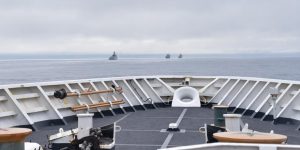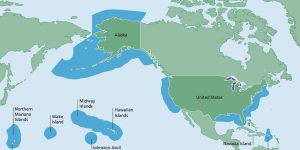U.S. Coast Guard Patrols U.S. Exclusive Economic Zone in Alaska
 On a recent patrol of the Bering Sea and Arctic regions, the U.S. Coast Guard reportedly established contact with the Chinese People’s Liberation Army Navy (PLAN). Among the patrol vessels were the BERTHOLF and the KIMBALL, both 418-foot legend-class security cutters. In addition to these vessels, the HEALY, a 420-foot medium icebreaker was on the scene.
On a recent patrol of the Bering Sea and Arctic regions, the U.S. Coast Guard reportedly established contact with the Chinese People’s Liberation Army Navy (PLAN). Among the patrol vessels were the BERTHOLF and the KIMBALL, both 418-foot legend-class security cutters. In addition to these vessels, the HEALY, a 420-foot medium icebreaker was on the scene.
It is reported that all exchanges between the U.S. Coast Guard and PLAN were in accordance with international standards established by the Western Pacific Naval Symposium’s Code for Unplanned Encounters at Sea and Convention on the International Regulations for Preventing Collisions at Sea.
The PLAN task force was reported to include a guided missile destroyer, an auxiliary vessel, and a general intelligence vessel. The Chinese vessels were reportedly conducting “military and surveillance operations” while deployed in the Bering Sea and North Pacific Ocean. They were sighted as close as 46 miles off the coast of Aleutian Island, but at no time did the PLAN task force enter U.S. territorial waters. Territorial waters are defined as 12 nautical miles from the baseline of a coastal state. Within this zone, the coastal state exercises full sovereignty over the air space above the sea and over the seabed and subsoil.
“Security in the Bering Sea and the Arctic is homeland security,” said Vice Adm. Michael McAllister, commander Coast Guard Pacific Area. “The U.S. Coast Guard is continuously present in this important region to uphold American interests and protect U.S. economic prosperity.”
What is an EEZ?
 The U.S. Exclusive Economic Zone is an area that encompasses 3.4 million square nautical miles of ocean. Coastal States assume jurisdiction over the exploration and exploitation of marine resources in their adjacent sections of the continental shelf, defined by a 200 nautical mile area off the coast. Within this area, a state or a nation may claim and exercise sovereign rights and exclusive fishery management authority over all fish and all Continental Shelf fishery resources.
The U.S. Exclusive Economic Zone is an area that encompasses 3.4 million square nautical miles of ocean. Coastal States assume jurisdiction over the exploration and exploitation of marine resources in their adjacent sections of the continental shelf, defined by a 200 nautical mile area off the coast. Within this area, a state or a nation may claim and exercise sovereign rights and exclusive fishery management authority over all fish and all Continental Shelf fishery resources.
U.S. EEZ areas include coastal states as well as the Commonwealth of Puerto Rico, Guam, American Samoa, the U.S. Virgin Islands, the Commonwealth of the Northern Mariana Islands, and other territories or possessions over which the United States exercises sovereignty. Over 900,000 square nautical miles exist in Alaska alone, and more than 50% of our nation’s seafood is harvested from this EEZ area, with an annual value to the economy of more than $5 billion.
An Exclusive Economic Zone (EEZ) is a concept that was approved at the Third United Nations Conference on the Law of the Sea in 1982.
 Maritime Injury Law Blog
Maritime Injury Law Blog

